The photographs presented here may be freely used for any non-commercial purpose, but please credit the respective photographers. For commercial use, please contact the photographers directly.
 |
Atelopus varius is a Critically Endangered harlequin toad that was once abundant in Costa Rica and western Panama. Declines began at Monteverde in 1988, and by 1996 it was believed to be extinct in Costa Rica. Serious population crashes have also taken place in Panama, although it has been recorded there as recently as 2002. A small population was rediscovered in Costa Rica in 2003. The cause of its decline is possibly a result of the fungal disease, chytridiomycosis, the incidence of which may be related to extreme climatic events, in particular drought. Photo © Robert Puschendorf. |
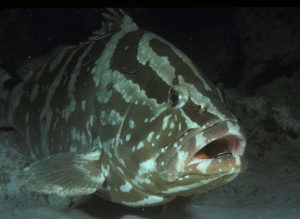 |
Nassau Grouper (Epinephelus striatus) is a large, coral reef fish occurring from Bermuda and Florida throughout the Bahamas and Caribbean Sea. The species is fished both commercially and recreationally, with much of the catch coming from spawning aggregations. Suitable habitat for this grouper is also believed to be in decline, with 29% of coral reef habitat in the Caribbean estimated to be under high risk of degradation from human activities. The global population of Nassu Grouper has declined by approximately 60% over the last 30 years and the species is listed as Endangered. Photo © John E. Randall. |
 |
The Palila (Loxioides bailleui) is a large Endangered finch found only on Hawaii, USA. The species was abundant on the island until the beginning of the twentieth century. However, it is now restricted to a very small range and its subalpine forest habitat continues to decline due to severe overgrazing by feral ungulates and invasion of introduced weeds. Nestlings are also preyed upon by Short-eared Owls, feral cats and introduced rats. Photo © Jack Jeffrey Photography. |
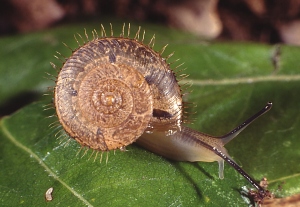 |
Dlinza Forest Pinwheel (Trachycystis clifdeni) is a Critically Endangered snail known only from Dlinza forest, South Africa. The forest is protected under KwaZulu-Natal Wildlife, however, it is a very small area (only 250 hectares) within an urban location and there is concern that the species may be negatively impacted by extreme stochastic weather conditions and climate change. Photo © Dai G. Herbert. |
 |
Verreaux’s Sifaka Lemur (Propithecus verreauxi) is endemic to Madagascar and is assessed as Vulnerable. This lemur’s deciduous forest habitat is being cleared for timber, firewood and charcoal production, resulting in a fragmented habitat that is also at risk from fires. The species is also hunted in some areas of the island. Photo © Troy Inman. |
 |
The Cucumber Tree (Dendrosicyos socotrana) is an unusual Vulnerable endemic from the island archipelago of Soqotra, Yemen. The species is very well adapted to withstand drought conditions and should therefore be better able than many species to tolerate any drying out of the Archipelago due to climate change. However, in times of severe drought, trees are cut-down, pulped and fed to livestock, and in some areas this has resulted in its almost total eradication. Declining habitat quality is also preventing regeneration of the plant. Photo © Anthony G. Miller. |
 |
The Painted Terrapin (Callagur borneoensis) is a Critically Endangered freshwater turtle found in southern Thailand, Peninsular Malaysia and Borneo. Painted terrapins are exploited for their eggs, which are sold for human consumption in many parts of Asia. Habitat destruction and disruption of breeding sites also threaten the species. These threats combined are causing serious declines in the population. Photo © Peter Paul van Dijk. |
 |
The Shark Ray (Rhina ancylostoma), also known as the Bowmouth Guitarfish, is a widely distributed Indo-west Pacific inshore species taken by multiple artisanal and commercial fisheries throughout its range, both as a target species and as bycatch. The animal’s flesh is sold for human consumption in Asia and the fins from the larger fish fetch exceptionally high prices. It is assessed as Vulnerable. Photo © Jeremy Stafford-Deitsch.. |
 |
The Pokemeboy (Acacia anegadensis) is a Critically Endangered species endemic to the small island of Anegada in the British Virgin Islands. The island is under extreme pressure for residential and tourism developments and this has already caused habitat fragmentation and loss. In the past, the tree was used for timber and the resin used as a boat sealant. Photo © Colin Clubbe. |
 |
The Corroboree Frog (Pseudophryne corroboree) is a spectacular but Critically Endangered frog that has declined dramatically in distribution and abundance. It is now restricted to a few fragmented populations in subalpine and montane areas of New South Wales, Australia. Fewer than 250 mature individuals are thought to survive in the wild. Photo © Harold Cogger. |
 |
The Fabulous Green Sphinx Moth (Tinostoma smaragditis) was listed as Extinct in 1996, but in February 1998 a single male was attracted to a light trap on its home island of Kauai, Hawaii. Since 1998, further individuals have been trapped, but the species is listed as Endangered due to the impacts of invasive species on its habitat. Photo © Mandy Heddle. |
 |
Seychelles Scops-owl (Otus insularis) has been downlisted from Critically Endangered to Endangered because there is new evidence that its extremely small population is stable and possibly increasing. Upland forests have increased in extent over the last 40 years due to re-growth of forests following long-term reduction of the cinnamon, coconut and logging industries. However, the species has an extremely small population that is susceptible to stochastic events and the effects of introduced taxa. Photo © Dave Currie. |
 |
Comoro Black Flying Fox (Pteropus livingstonii) is the largest and rarest bat found in the Comores and is listed as Critically Endangered. It lives in montane forest on the islands of Anjouan and Moheli where its habitat is declining as a result of deforestation and periodic cyclones. Cyclones can destroy roosts and feeding sites as well as directly killing some bats. The population is declining rapidly. Photo © Richard Wainwright |
 |
Paretroplus menarambo is a freshwater fish endemic to Madagascar and epitomizes captive breeding efforts to save threatened Malagasy fish. The last reports of this species in the wild were in the late 1990s and it is now listed as Extinct in the Wild. However, breeding populations are maintained in captivity thanks to animals collected in 1993 and shipped back to Old World Exotic Fish in Homestead, Florida, USA. The main causes for the loss of this species were deforestation, which had a detrimental effect on the species freshwater habitat, introduced alien species, and overfishing. Photo © Paul Loiselle. |
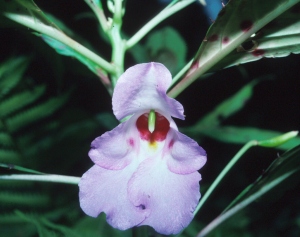 |
Impatiens letouzeyi is endemic to Cameroon. The plant was described in 1981 from a single specimen collected in the 1970s. It was rediscovered by an Earthwatch team in 1998 and subsequently found to be fairly common in the Kodmin-Edip area. However, given its restricted range, a planned reservoir scheme in the area may threaten a major part of the population and the species is currently assessed as Endangered. Photo © Ben Pollard. |
 |
The Anegada Ground Iguana (Cyclura pinguis) was once distributed over the entire Puerto Rico Bank, but today is confined to the island of Anegada in the British Virgin Islands. The iguana is susceptible to predation by humans and their dogs and cats and it is believed that this may have resulted in the contraction in the species’ range. It is listed as Critically Endangered and a reintroduction programme is currently in place. Photo © Glenn Gerber. |
 |
Leptopelis susanae is an Endangered treefrog that occurs only in the Gughe Mountains of southern Ethiopia. The species is threatened by forest clearance, human settlement and agricultural encroachment: the Gughe Mountains are heavily populated and intensively cultivated, and only small patches of montane forest remain. Photo © Malcolm Largen. |
 |
Basking Malachite Damselfly (Chlorolestes apricans) is a localized endemic from the Eastern Cape, South Africa. In 1975 the species was known from ten sites, but in 2000 it was found at only two sites. The species is listed as Endangered and is severely threatened by cattle trampling of stream banks and the effects of habitat shading by the alien invasive tree Acacia mearnsii. Further threats come from detergent entering the streams from washing of clothes and possibly also the effect of predation from rainbow trout. Raising the profile of this species is now leading to conservation action. Photo © Michael Samways. |
 |
The Dragon Tree (Dracaena cinnabari) forms characteristic woodlands on the island of Soqotra, Yemen, but has a fragmented distribution and in some areas the tree is failing to regenerate. It is listed as Vulnerable. The tree grows best in areas affected by mists, low cloud and monsoon drizzle. A major cause of its decline is likely to be climate change (the Archipelago is gradually drying out). Over-exploitation of Dragon’s Blood (a resin from the bark) and felling trees for beehive wood may also threaten the species. Photo © Anthony G. Miller. |
 |
The Hawaiian Crow (Corvus hawaiiensis) is now listed as Extinct in the Wild after the last two known wild individuals disappeared from Hawaii in 2002. Habitat alteration, collecting and shooting, introduced predators (e.g., rats, the Indian mongoose) and predation from the native Hawaiian Hawk, and avian malaria and pox carried by introduced mosquitoes have contributed to the crow’s decline. Some individuals remain in captive breeding facilities and a reintroduction plan is being developed. Photo © Jack Jeffrey Photography. |
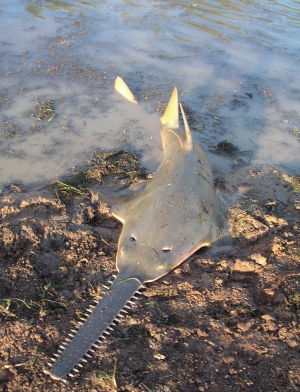 |
Largetooth Sawfish (Pristis microdon) is a large, Endangered species of sawfish that is wide-ranging in the Indo-West Pacific, in freshwater or inshore coastal waters. The distinctive rostrum that gives the species its name is highly sought after, but is also often responsible for the species becoming entangled in fishing nets as bycatch. Virtually all known populations have experienced very serious declines. The species is also threatened by habitat loss and degradation over most of its range. Photo © R. Mitchell. |
 |
Nectophrynoides viviparus is one of the few frogs that give birth to live young. This Vulnerable species occurs in the Uluguru and Udzungwa Mountains and in the Southern Highlands of Tanzania. It is threatened by ongoing forest loss, especially at lower altitudes, due to agricultural encroachment, wood extraction and expanding human settlements. Photo © David Moyer – Wildlife Conservation Society. |
 |
Scimitar-horned Oryx (Oryx dammah) was once one of the most common large mammals of northern Africa. Overhunting for the animal’s meat, hide and magnificent horns, combined with habitat loss and caused major declines in the species and by the end of the 20th century none were known to remain in the wild. Currently listed as Extinct in the Wild, the species is now part of a major captive breeding and reintroduction programme. Photo © Antonio di Croce. |
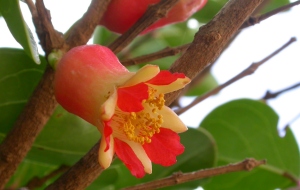 |
The Pomegranate Tree (Punica protopunica) is a close relative of the cultivated pomegranate and is endemic to Soqotra, Yemen. Although the population is apparently stable at present it has evidently declined in the past, for reasons that are not certain. It has a severely fragmented distribution and over large areas the tree is absent except for small relict populations with no apparent regeneration. The tree is listed as Vulnerable. Photo © Anthony G. Miller. |
 |
The Keeled Box Turtle (Pyxidea mouhotii) inhabits the forest floor leaf litter of localized areas of evergreen forests from northeastern India through Myanmar, Lao PDR and Viet Nam to southern China. This Endangered species has been harvested in large numbers for the Asian turtle consumption trade, as well as for the international pet trade. Populations have disappeared and remaining populations, including those in formally designated protected areas, appear to be declining. Photo © Peter Paul van Dijk. |
 |
Channel Islands Fox (Urocyon littoralis) is a Critically Endangered canid restricted to six of the California Channel Islands off the coast of southern California, USA. The population has suffered declines of more than 80% in recent years, primarily caused by golden eagle predation and possibly also introduction of canine disease such as canine distemper virus (CDV). Population decline is expected to continue. Photo © Timothy J. Coonan. |
 |
Kirtland's Warbler (Dendroica kirtlandii) breeds in northern USA, and has a small winter range in the Bahamas and Turks and Caicos islands. Breeding habitat has declined by 33% since the 1960s. The species suffered major declines in the early 1900s and in the 1960s. Since 1987, conservation action has successfully increased the population of this species. Its occupied breeding and wintering ranges are now considered large enough to warrant downlisting this species to Near Threatened. Photo © Dave Currie. |
 |
Yellow-crowned Butterflyfish (Chaetodon flavocoronatus) is known only from Guam in the western Pacific. It is a coral-reef species, occurring among black-corals. This Vulnerable fish is relatively rare and appears irregularly in the aquarium trade. Little is known about its biology. Photo © Tim Allen (c/o Robert Myers). |
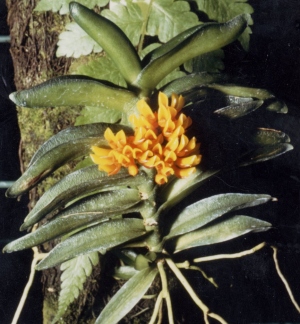 |
Ossiculum aurantiacum is a highly attractive, Critically Endangered orchid endemic to the Cameroon. It has not been seen again in the wild since it was first collected in 1980, despite intensive searching in the area. The recent construction of a road gives greater access to this plant’s only known location and may result in more forest clearance and encroachment agriculture into the area. Photo © Frank van der Laan. |
 |
Hyperolius rubrovermiculatus is an Endangered African reed frog, only known from the Shimba Hills in coastal Kenya, where it is intrinsically at risk because of its small range. The species can survive in somewhat degraded habitats, but cannot tolerate complete opening up of its forest and dense savanna habitat. It is likely to be affected by agricultural expansion and increasing human settlements. Photo © de Saix. |
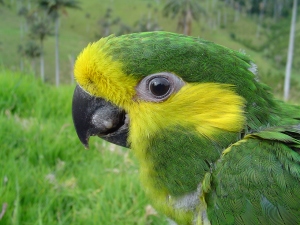 |
Yellow-eared Parrot (Ognorhynchus icterotis) is Critically Endangered because its known range (especially the nesting area) is extremely small. Suitable habitat is severely fragmented throughout its historical range and continues to be lost and degraded. Currently, it is known only to remain in the Central Andes of Colombia. Conservation action is addressing some of the key issues but the future of this species remains extremely uncertain. Photo © Fundacion ProAves (c/o Paul Salaman). |
 |
Humphead Wrasse (Cheilinus undulatus) is widely distributed on coral reefs and inshore habitats throughout much of the tropical Indo-Pacific, but it is nowhere common. Wherever it is fished, even if only moderately, density quickly declines and it appears now to have disappeared from several locations. It is particularly heavily exploited at the centre of its range in southeastern Asia for the live reef fish trade. Fishery-dependent and trade-related data suggest overall declines of at least 50% over the last 30 years, which qualifies this fish for an Endangered listing. Photo © John E. Randall. |
 |
Pittosporum tanianum was first discovered in 1988 in New Caledonia. It was thought to have become Extinct in 1992, but in 2002 it was rediscovered and is now listed as Critically Endangered. Three plants are now known to exist, giving this species a tenuous lifeline to avoid extinction. Loss and degradation of its sclerophyllous forest habitat is the main threat to the species. Photo © Bernard Suprin. |
 |
Slender Loris (Loris tardigradus) from Sri Lanka is assessed as Endangered. Habitat fragmentation over the years has seriously reduced the area available for this species. Between 1956 and 1993, Sri Lanka lost more than 50% of forest cover to human activities, followed by a similar rate of decline in the remaining forest cover between 1994 and 2003. Photo © Anna Nekaris. |
 |
The Alerce (Fitzroya cupressoides) is confined to southern Chile and Argentina and is listed as Endangered. This is one of the largest trees in temperate South America and has been heavily logged since the end of the 16th century. The species has been removed from nearly all lowland sites, and at higher altitudes the trees are often burnt and illegally logged. Present estimates of the area occupied by the remaining stands is 20,000 ha, 15% of their original extent when Europeans arrived. Photo © Cristian Echeverria. |
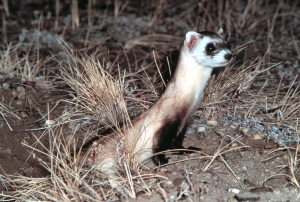 |
Black-footed Ferret (Mustela nigripes) is currently listed as Extinct in the Wild, pending reassessment. This ferret is one of North America’s rarest mammals and it depends on an endangered ecosystem for survival. The population declined throughout the 1900s and in 1985, the last known free-ranging population collapsed due to an outbreak of canine distemper and the species was considered Extinct in the Wild. Through a successful captive breeding and re-introduction programme, Black-footed Ferrets are making a come-back. Photo © Dean Biggins. |
 |
Mutisia magnifica is a Vulnerable vine endemic to Ecuador. The species is found in vegetation remnants, which are seriously threatened by wood extraction for charcoal production. Photo © Carmen Ulloa Ulloa. |
 |
Damba Mipentina (Paretroplus maculatus) inhabits the Betispoka and Mahajamba river basins, Madagascar. This Critically Endangered fish has suffered rapid declines over the last decade due to severe fishing pressure, the impact of introduced alien species, and habitat destruction. Photo © Paul Loiselle. |
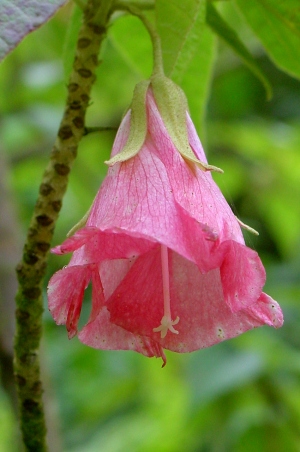 |
St Helena Redwood (Trochetiopsis erythroxylon) is a tree endemic to St. Helena and is Extinct in the Wild. After settlers arrived on the island, the species was heavily exploited for its excellent timber and bark which was used for tanning hides. By 1718, the species was already extremely rare. Further losses occurred when flax plantations began in the late 1800s. By the mid 20th century, only one redwood survived and this single tree is the source of all the Redwoods known in cultivation today. Inbreeding depression and a depauperate gene pool form the most serious threat to the future survival of this species. Photo © Rebecca Cairns-Wicks. |
 |
Tylototriton shanjing is a crocodile newt from central, western and southern Yunnan, China. Although still very common in parts of its range, over-harvesting for use in traditional Chinese medicine is becoming a serious threat. It is also becoming popular in the international pet trade. The species is not listed as threatened at present, but it is currently in serious decline and is assessed as Near Threatened. Photo © Henk Wallays. |